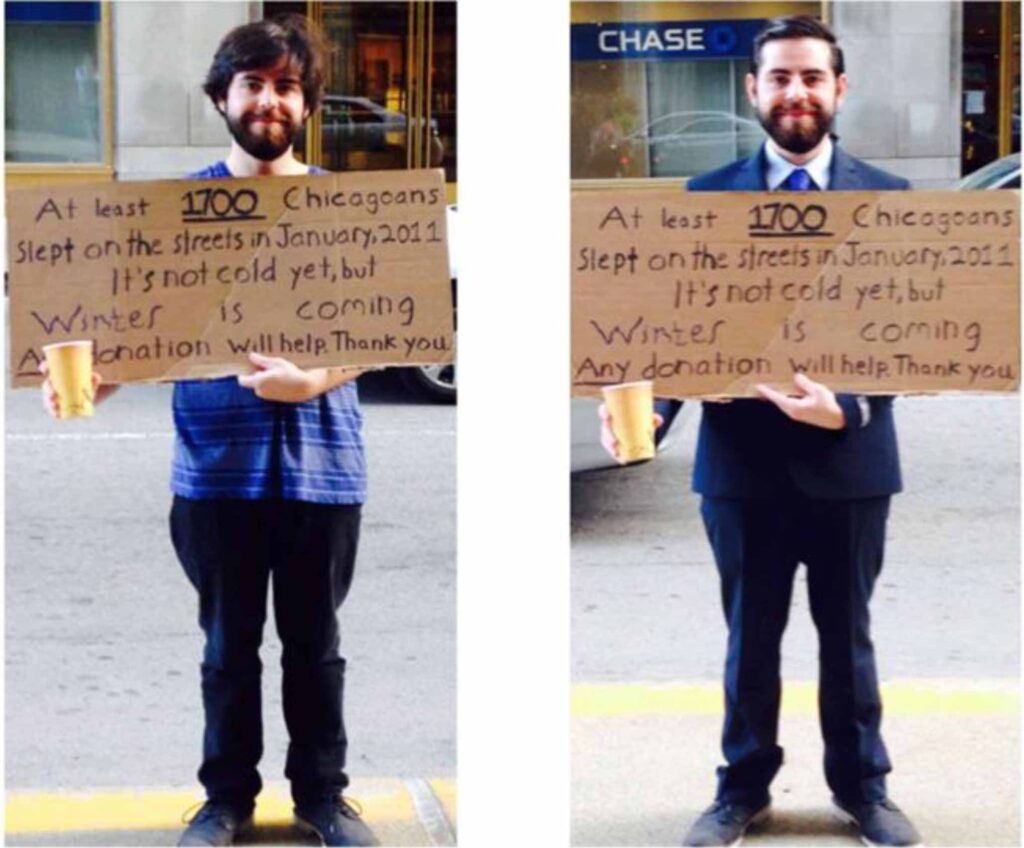A new study by Bennett Callaghan of the Stone Center, Quinton Delgadillo, and Michael Kraus investigates how signals indicating relatively higher or lower social class are linked to helping people in need.
A man, seemingly homeless, stands on a busy urban street, asking for money. Is he more likely to be successful if he’s dressed in rags — and therefore apparently in dire need — or in clothes that suggest he hasn’t fallen so low on the socioeconomic ladder?
The question has implications for how individuals and, possibly, institutions make decisions related to charitable donations and assisting people in need. A recently published study by Bennett Callaghan, associated researcher at the Stone Center, Quinton Delgadillo of Columbia Business School, and Michael Kraus of Yale University, found that perceptions of status are an important factor in deciding whether an individual is considered “deserving” of compassion, but not necessarily in the way one might expect.
In their study, the researchers conducted a field experiment in New York and Chicago. Callaghan, the lead author, also served as an actor, or confederate, in the study: on consecutive days, he stood on various street corners in the cities, soliciting donations for the homeless while dressed in ways that suggested either relatively lower or higher social status. On the lower status days, he wore baggy jeans and a t-shirt, and wore his long hair loose and shaggy. On higher status days, he wore a business suit, dress shirt, and tie, and kept his hair slicked back. In both conditions, he held a cardboard sign with a message about unhoused people, carried a paper coffee cup for collecting donations, and occasionally said “Collecting money to help the homeless” in order to attract attention from pedestrians. Throughout the experiment, he maintained a natural facial expression and tone of voice. (To avoid intentionally misleading study participants, he did not claim to be homeless himself.)
The researchers found that passersby gave more than twice as much money — giving more often, as well as larger donations — to Callaghan when he was dressed in higher status clothes than in lower status clothes: a total of $54.11 over the course of a cumulative 3.5 hours, compared to $21.15 over 4 hours. In addition, all of the donations of $5 or more were received when Callaghan was in higher-status clothes. (All of the money received was donated by the researchers to local charities for the homeless.)
The researchers conducted an online follow-up experiment based on images of Callaghan. About 500 participants were tested on whether Callaghan, when dressed in the lower status clothes, was seen as less competent, less warm, and, in a sense, less human — qualities that previous research has shown to decrease compassionate responding — than when he was dressed in higher status clothes. The results were in line with the researchers’ expectations that these psychological perceptions, which commonly precede expressions of compassion, arose from perceiving these status symbols.
The researchers also considered whether the novelty of a man dressed in a suit asking for money simply drew more attention from passersby, and therefore greater donations. However, findings from both the field experiment and the online experiment suggested that this was likely not a factor. Specifically, participants in the field study were no more likely to interact with Callaghan in ways not related to giving money (e.g., saying something to him in passing or stopping to talk to him) when he was dressed in relatively higher-status clothing; moreover, when participants in the online experiment were briefly shown wide-angle images of Callaghan standing on a populated street (where all aspects of the image were kept the same except for his clothing) and asked to list all of the things they noticed in the image, they were no more likely to include him when he was dressed in higher- rather than lower-status clothing.
The study shows that perceptions of social class can have a significant influence on compassionate responses. It also suggests the limits of relying on the generosity of individuals in order to address structural problems including poverty, homelessness, and inequality. Even the most well-intentioned individuals and charities are subject to these types of biases when making decisions, the researchers note, leading to broader implications for how society chooses to help people in need.
Read the Paper:
The Influence of Signs of Social Class on Compassionate Responses to People in Need (open access)


